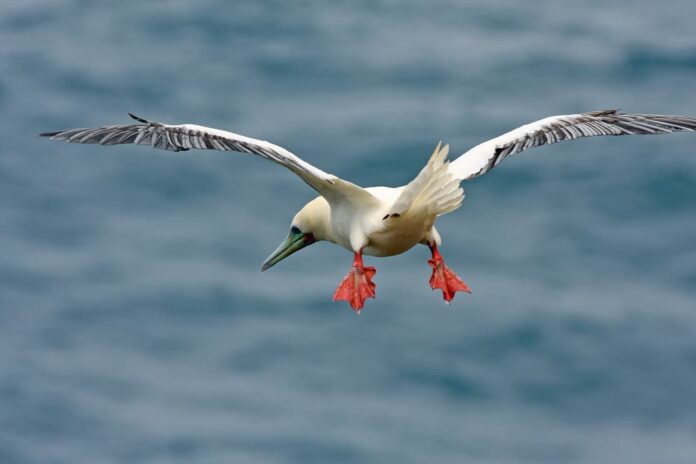The red-footed booby is one of the 7 members of the booby birds, a rare bird with red feet. It is interesting how the root of their name comes from the Spanish slang term “bobo” which means stupid. That was because they had a habit of landing on board sailing ships where people can easily capture and eat them. Want to know more about the red-footed boobies? Let’s find out more about them below.
1Appearance

A red-footed booby grows to about 70 centimeters in length with a wingspan of up to 1.52 meters. This size makes it the smallest among the booby family members. It has a long conical bill, slender neck, long narrow wings, and a long pointed tail. The adults of these birds always have red feet though the plumage color varies with brown and white morph birds. The white morph birds are mainly white with light buff or orange on the head with black wings. As for the brown morph birds, they are mid-brown all over with darker flight feathers. However, both morphs have pale blue bills with pink base, pink facial skin, and bright red feet and legs.
Fun Fact: Male red-footed boobies use their pretty red feet to attract mates during the breeding season. Males with the brightest red feet have the best chance of getting a mate.
2Behavior

Red-footed boobies have a wide distribution in the tropics, and they breed in coastal regions. During the breeding season, hundreds or even thousands of them may gather to pair up and mate. These birds breed in colonies, and they usually breed on islands where they lay their chalky blue eggs. A female lays only one egg every 15 months, and both parents care for their chicks. When not breeding, they spend most of their time at sea. Red-footed boobies feed at sea, nest on land, and perch in coastal trees and shrubs.
3Feeding & Habitats

These boobies are strong flyers, and they can travel up to 93 miles in search of food. As seabirds, they mainly eat small fish that they dive to catch or squids that gather in groups near the surface. They hunt in large groups, and they can snare flying fish from the air as well. The coolest part is their hunting skill, and it is so fascinating. They have aerodynamic and lean bodies, closeable nostrils, and long wings that they wrap around their bodies before entering the water. It is so easy for them to plunge-dive and capture fish that they spot from the above with their sharp eyes.
Red-footed boobies do not migrate, and they live in subtropical and tropical regions of the Atlantic, Indian, and Pacific Oceans. Their distribution also spreads across the Caribbean Sea and some seas in the north of Australia. They are more abundant around the Galapagos where they nest on coral atolls or volcanic islands. Along with that, they also nest in the branches of small trees or on top of shrubs. As pegalic ocean-faring birds, they come to land only to mate.
4Predators & Threats

Rats are the main predators that take chicks and unguarded eggs during the breeding season. More than that, large owls and other birds of prey are also their predators as well. The red-footed booby is facing both manmade and natural threats which cause population decline from year to year. The fishing industry thins their food source while coastal development for human habitats affects their habitats. Not to mention plastic pollution, tourism development, and water pollution, things are not great. Red-footed boobies are also vulnerable to El Nino weather conditions that can dramatically impact their population. The good thing is that they are still listed as Least Concern on the IUCN Red List.
Related Post: Blue-Footed Booby Facts




